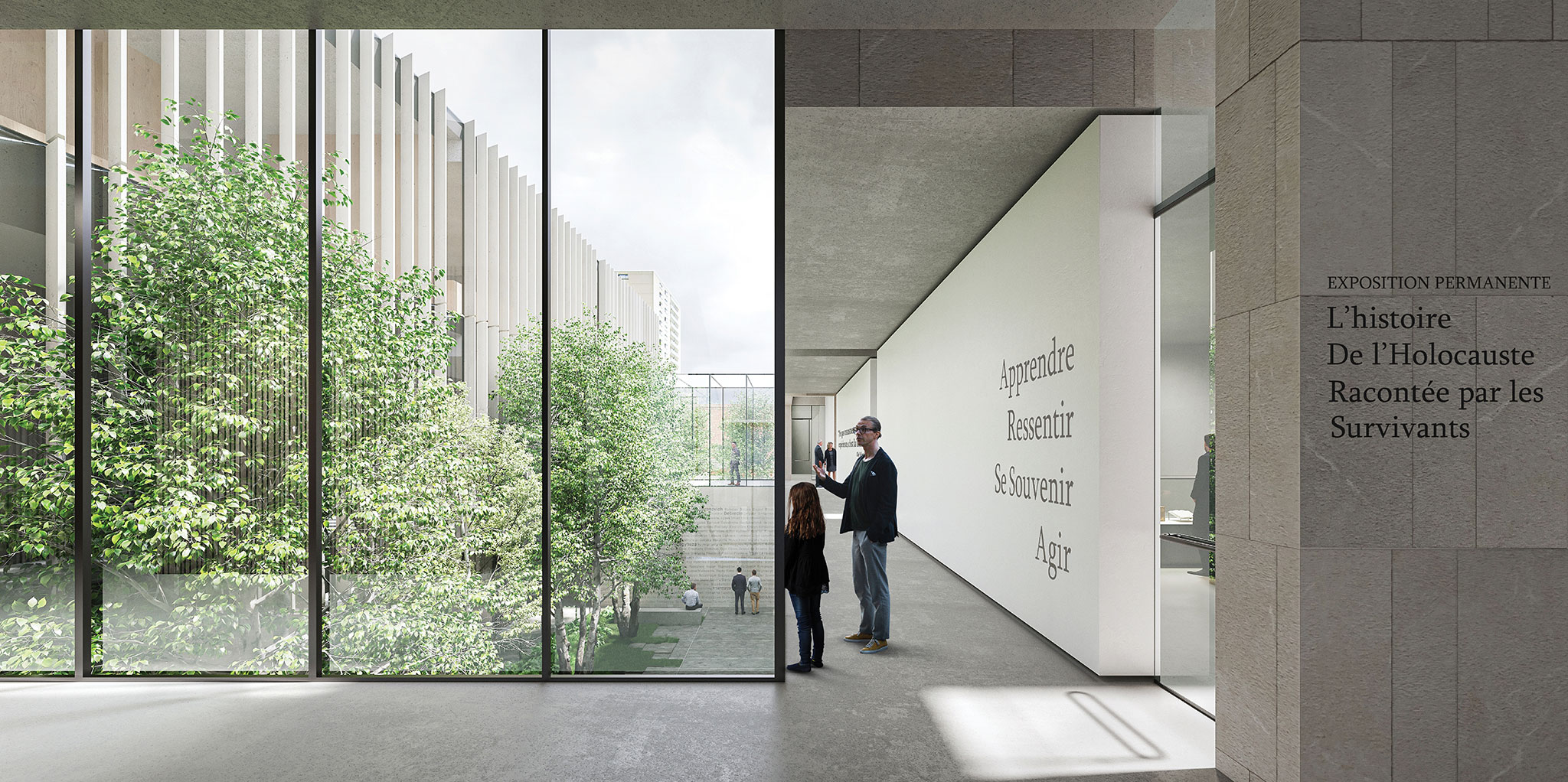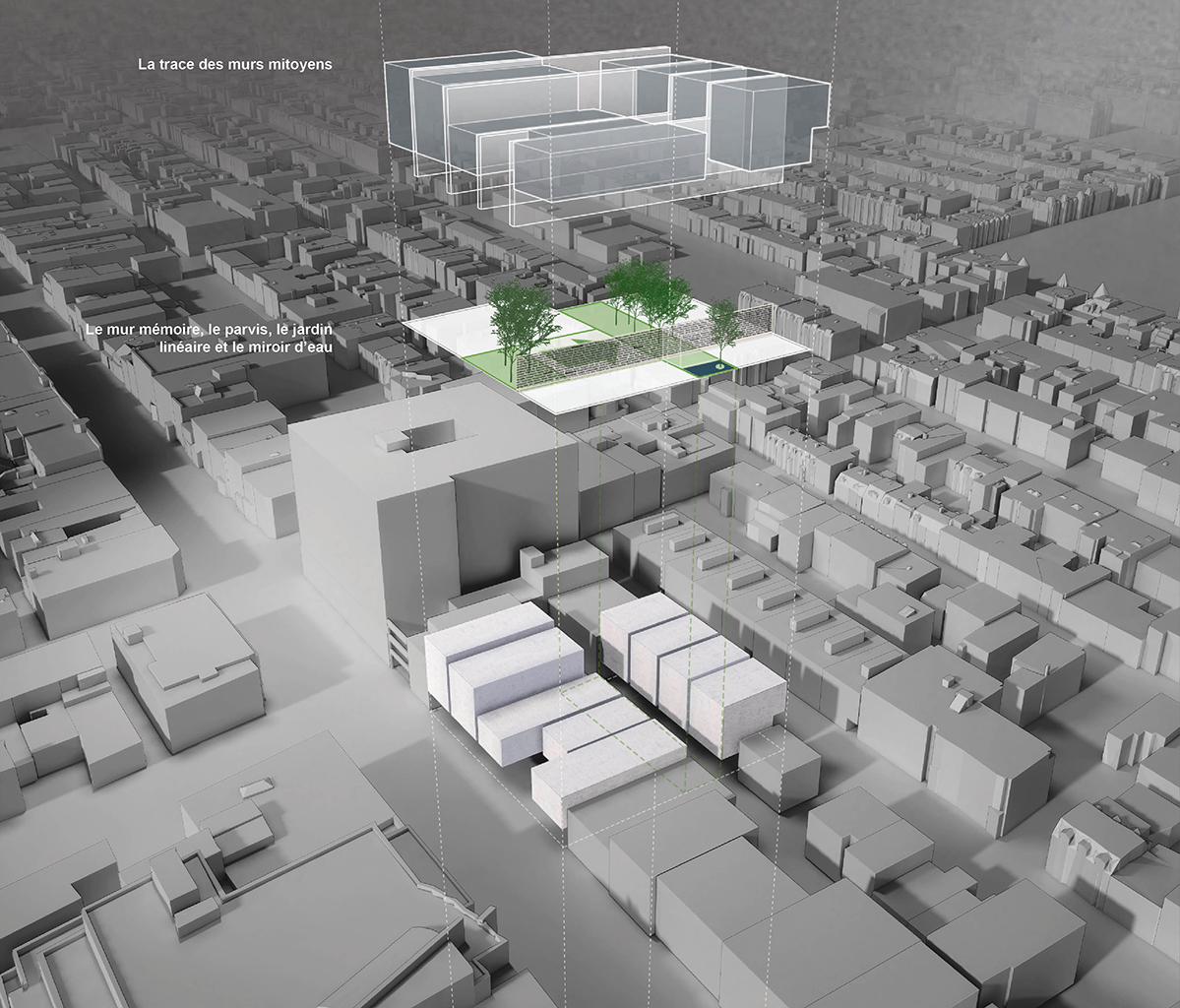The MHM is moving from its current Cote-des-Neiges location in response to a growing demand for its educational programs about the Holocaust, genocide, and human rights. Facing a rise in racism, antisemitism, and discrimination, the new MHM will have a broader impact in galvanizing communities throughout Quebec and Canada to fight all forms of hatred and persecution.
The Museum’s Give Voice fundraising campaign has raised €82 million of the €90 million project with generous contributions from Heritage Canada (€20 million), the Ministère de la Culture et des Communications du Québec (€20 million), the City of Montreal (€1.5 million), the Azrieli Foundation (€15 million) and numerous private donors.
The 32 projects received in the first stage of the architectural competition are available in the Canadian Competitions Catalogue.

Montreal Holocaust Museum by KPMB Arch + Daoust Lestage Lizotte Stecker Arch.

Montreal Holocaust Museum by KPMB Arch + Daoust Lestage Lizotte Stecker Arch.
Excerpt from the competition text KPMB Architects + Daoust Lestage Lizotte Stecker Architecture
Step 1.
A reading of the past turned towards the future.
Along the lively boulevard, a commemorative wall challenges, embraces and guides the curious towards the heart of an urban block, with an interior garden, space reserved for contemplation and a water mirror. Finding roots in this calm, the museum unfolds above and all around, allowing today's gaze to discover a treasure trove of objects and stories, to make sense of difficult pasts, to envisage the path towards the future, combining generation, identity and community in the plural.
Memory, education and community, the three pillars that structure any Holocaust museum, have always been guided by the motto: “Never again”. Yet the strength of this message is waning as death approaches the last witnesses and as we witness the resurgence of populism, revisionism, anti-Semitism and devastating wars.
Designing and building this Holocaust museum in a context dominated by doubt about the future raises new questions. Our museum will not seek to represent the Shoah in a monumental form. He will remain close to the Jewish tradition, avoiding dogma, choosing rather the always unfinished commentary, the open conversation.
Reweaving the urban fabric.
Since the beginning of the 20th century, Saint-Laurent Boulevard has been at the heart of Jewish community life. Nicknamed "the Main", the street has welcomed many immigrant identities over the years, reinforcing a vibrant culture of diversity and tolerance located between east and west, French-speaking and English-speaking areas, continually reinventing itself, inventing new stories of survival and resistance. Our museum wants to participate fully in this story of the Hand.
The urban morphology of the district inspires the volumes and the geometric plan of our architectural concept, defined by the rhythmic repetition of lines of natural light echoing the adjoining walls of the site, as well as by the presence of a natural landscape formalized by the presence of birches in the heart of the island in continuity with the adjacent interior courtyards. By respecting the rhythm of the traditional lots, by reproducing the scale and rhythm of the buildings along Saint-Laurent Boulevard, our museum will blend into the urban fabric.

Montreal Holocaust Museum by KPMB Arch + Daoust Lestage Lizotte Stecker Arch.
2nd step.
The new beginnings.
Memory, education and community, the three pillars that structure any Holocaust museum, have always been guided by the motto: “Never again”. Yet as so many survivors have asserted, the reality of the Holocaust cannot be fully and definitively grasped. Prose, images and objects, and representation in space can only offer a partial vision - we are not attempting the impossible, that is to say, the representation of the Shoah in a monumental architectural form. Clearly, this ambition is not suited to the present moment which compels us to raise new questions about the relevance of the past for the present and the future. It is this concern that inspired the design of our building. We aspire to honour Jewish tradition, avoiding dogma, embracing diversity, choosing dialogue and questioning, open conversation, and never-ending commentary.
In conversation with the city.
Since the beginning of the 20th century, Saint-Laurent Boulevard has been at the heart of Jewish community life. Nicknamed "the Main", the street has welcomed many immigrant identities over the years, reinforcing a culture of diversity and tolerance located between east and west, continually remaking itself, and inventing new stories of survival and resistance. Our museum wants to participate fully in this story of the Hand.
The urban morphology of the district inspires the volumes and the geometric plan of our architectural concept, defined by the rhythmic repetition of lines of natural light echoing the adjoining walls of the site. By respecting the rhythm of the traditional lots, and by reproducing the scale and rhythm of the buildings along Saint-Laurent Boulevard, our museum will blend into the surrounding fabric.
In response to their distinct urban character, the front and rear facades are different but connected by the same morphological grid. Along Saint-Laurent, at street level, the interface is bold, transparent and welcoming. At the level of the exhibition halls, the stone is opaque. On Saint-Dominique, the entry-level looks solid. On the other hand, the upper levels are more transparent, with a set of vertical claustral rebalancing the scale and the composition in order to ensure a careful integration with the residential context. The essence of the concept is based on the continuity of the two facades linked by the commemorative wall which crosses the entire site from the boulevard to the street.



































